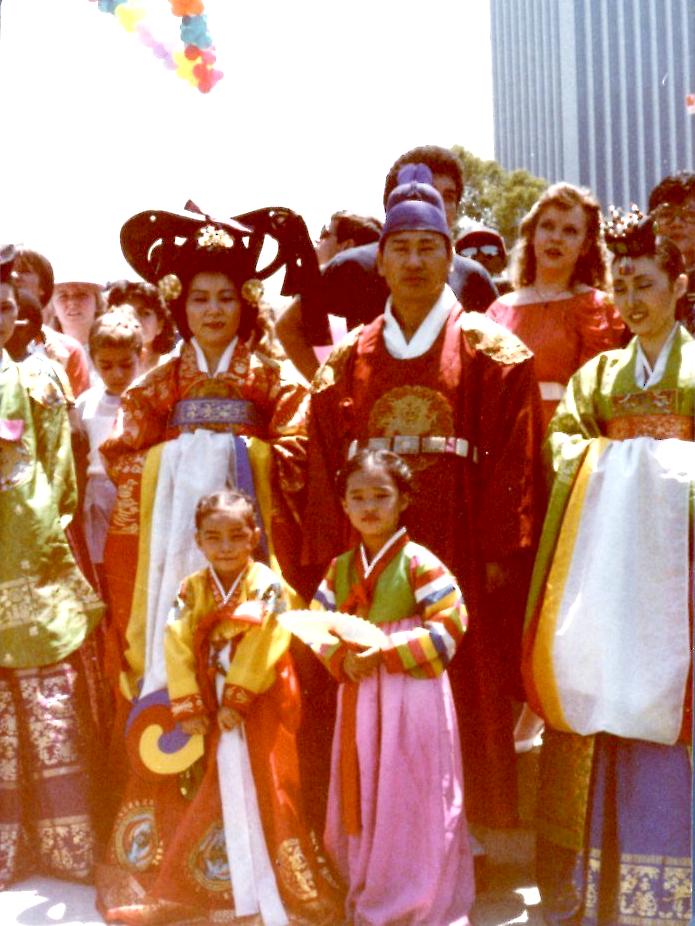

Historical Girls' Clothing: Asian Countries--Korea

Figure 1.--The afflience of South Korea have made them Korean women anomg the most fashopn concious in Asia. South Korean women and girls want to use fashion to express their individuality. Just the opposite is the case in North Korea where the state has instituted fashions which reflect the submission of the individual to totalitarian state control. Indivisuality in North Korea actually is dangerous. The hanbok is a rare matter of North-Sputh consensus. And as much as South Koreans are into modern fashions, there is a strong nostalgic attchment to the hanbok, especially for women and girls. The South Korean Ministry of Culture, Sports and Tourism established 'Hanbok Day' to encourage South Koreans to wear hanbok (1996).
|
|
Korea has been one of the most isolated countries in the world and Communist North Korea still is. Situated between China and Japan, the country has been conquered by both, but mananaged to preserve its independence and became known as the Hermit Kingdom, reflectings its desire to remain inndependnt of both its neighbors. Like both China and Japan girls and women wore colorful traditionalal garments. The basic traditional garment Hanbok (South Korea), known as the Joseon-ot in North Korea). The Hanbok is done in silk with vibrant colors and follows simple lines without any pockets. Hanbok translates as 'Korean clothing' and is the styles of the Joseon/Chosŏn dynasty. This was a long-lasting Korean kingdom (14th-19th centuries). Today the Hanbok is worn as formal clothing during traditional festivals and important family celebrations. Korea over its long history had a kind of dual clothing tradition rather similar to European monarcial traditions. The rulers and aristocracy adopted a variety of mixed foreign-influenced but indigenous styles. Commoners preserved a distinct style of indigenous clothing, today known as hanbok. What the commonors role were, however, not the expensive silk and colored hanbok garments of modern Korea. The photographic record shows both men and women wearing inexpensive white garmebts for eceryday wear. Japan first introduced Western garments to Korea during the colonial period, primarily school uniforms for children (1909-45). Since World War II Koreans have adopted Western fashion. This process began slowly, but accelerated as South Korea adopted capitalist economic policies and became one of the Asian Tigers (1970s). The afflience of South Korea have made them Korean women anomg the most fashopn concious in Asia. South Korean women and girls want to use fashion to express their individuality. Just the opposite is the case in North Korea where the state has instituted fashions which reflect the submission of the individual to totalitarian state control. Indivisuality in North Korea actually is dangerous. The hanbok is a rare matter of North-Sputh consensus. And as much as South Koreans are into modern fashions, there is a strong nostalgic attchment to the hanbok, especially for women and girls. The South Korean Ministry of Culture, Sports and Tourism established 'Hanbok Day' to encourage South Koreans to wear hanbok (1996).
HGC

Navigate the Girls' Historical Clothing Web Site:
[Return to the Main girls Asian country page]
[Return to the Main Korean country page]
[Return to the Main girls country page]
[Return to the Main girls page]
[About Us]
[Activities]
[Biographies]
[Chronology]
[Color]
[Countries]
[Difficult images] >> combine w/ photo interprtation
[Fashion]
[Families]
[Garments]
[Gender conventions]
[Hair]
[Literature]
[Photo intrpretation]
[School]
[Sisters]
[Return to the Historical Girls Clothing Home Site]
Created: 11:5 PM 7/29/2017
Last updated: 8:44 AM 12/11/2018




